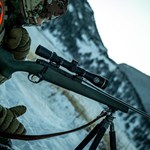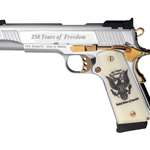
While turkey hunting is a popular outdoor pursuit in the springtime (and in some places, in fall), did you know that turkeys aren’t all the same? There are actually two species of huntable turkeys in the world. The ocellated turkey (Meleagris ocellata) is a blue-faced, colorful-feathered jungle bird found only in the Yucatan Peninsula of Mexico that sounds, acts and lives differently than the wild turkeys we’re more familiar with, but it is huntable, and several outfitters run Ocellated hunts in the Yucatan if this bird is on your bucket list.
But when most of us mention wild turkeys, we’re thinking of the other species, Meleagris gallopavo, of which there are actually five subspecies spread across North America. What are the differences between all these turkeys?

USFWS image
Eastern Turkeys
Eastern turkeys have the widest distribution, living in nearly the entire eastern half of the U.S., from the Gulf to Maine and from the East Coast to a little west of the Mississippi River. They’re big, strong birds, the largest of the subspecies, and they tend to have the longest beards on average. The tips of their tailfeathers are chestnut brown, and they have the strongest gobble of all the subspecies. Easterns are notoriously wary and difficult to call in, said to be second only to the Osceola.

Osceola (Florida) Turkeys
Osceolas look much like Easterns, though they tend to be a bit leaner and taller, with longer legs. The tips of their tail feathers are a slightly darker brown, and they often sport impressive spurs. They’re found only in Florida, and when you combine their limited distribution with the fact that they’re the most difficult subspecies to call in, Osceolas tend to be one of the tougher turkeys for a hunter to cross off their bucket list.

USFWS image
Rio Grande Turkeys
Rios are concentrated in Texas, Oklahoma and Kansas, but there are a sprinkling of them in other Western states, especially California and Oregon and, oddly enough, Hawaii (as a result of a relocation effort in the 1960s). The tips of their tail feathers are tan, and they’re average size with moderate spurs and beards. Rios tend to be vocal and respond more readily to calling than Easterns and Osceolas, with a higher-pitched gobble.

USFWS image
Merriam’s Turkeys
Merriam’s turkeys are found around the mountain West, showing off beautiful tail feathers tipped in a pale buff or white. Their gobble is even higher-pitched than the Rio’s. They have the weakest gobble, the shortest spurs and the shortest beards (on average) of all the subspecies.

Courtesy Mossberg
Gould’s Turkeys
Gould’s turkeys are mostly found in Mexico. The population does stretch up into southern Arizona and New Mexico a bit, though hunting them in either state is difficult, as both states issue a very limited number of tags that are difficult to draw. More than likely, you’ll be headed to Mexico to check this bird off your list. Gould’s have beautifully white-tipped tail feathers, moderate beards and spurs, and long legs similar to an Osceola.

Ocellated Turkeys
As mentioned, these birds are their own species, found only in the Yucatan Peninsula. They have colorful, iridescent feathers that make them look like a peacock/turkey hybrid. They have very long spurs and no beards at all, and they’re smaller than any other turkey. Rather than gobbling in the way other turkeys do, ocellated turkeys make high, warbling sort of singing noise.
Turkey Slams
If you love hunting turkeys—and it’s addicting once you get started—you might someday decide to pursue a turkey slam. Turkey hunting has three major “slams” a hunter can complete:
- A Grand Slam is taking each of the four subspecies in the U.S.: an Eastern, an Osceola, a Rio Grande and a Merriam’s.
- A Royal Slam is a Grand Slam plus the fifth subspecies, the Gould’s.
- A World Slam is taking all five wild turkey subspecies plus the ocellated—every huntable turkey in the world.















































